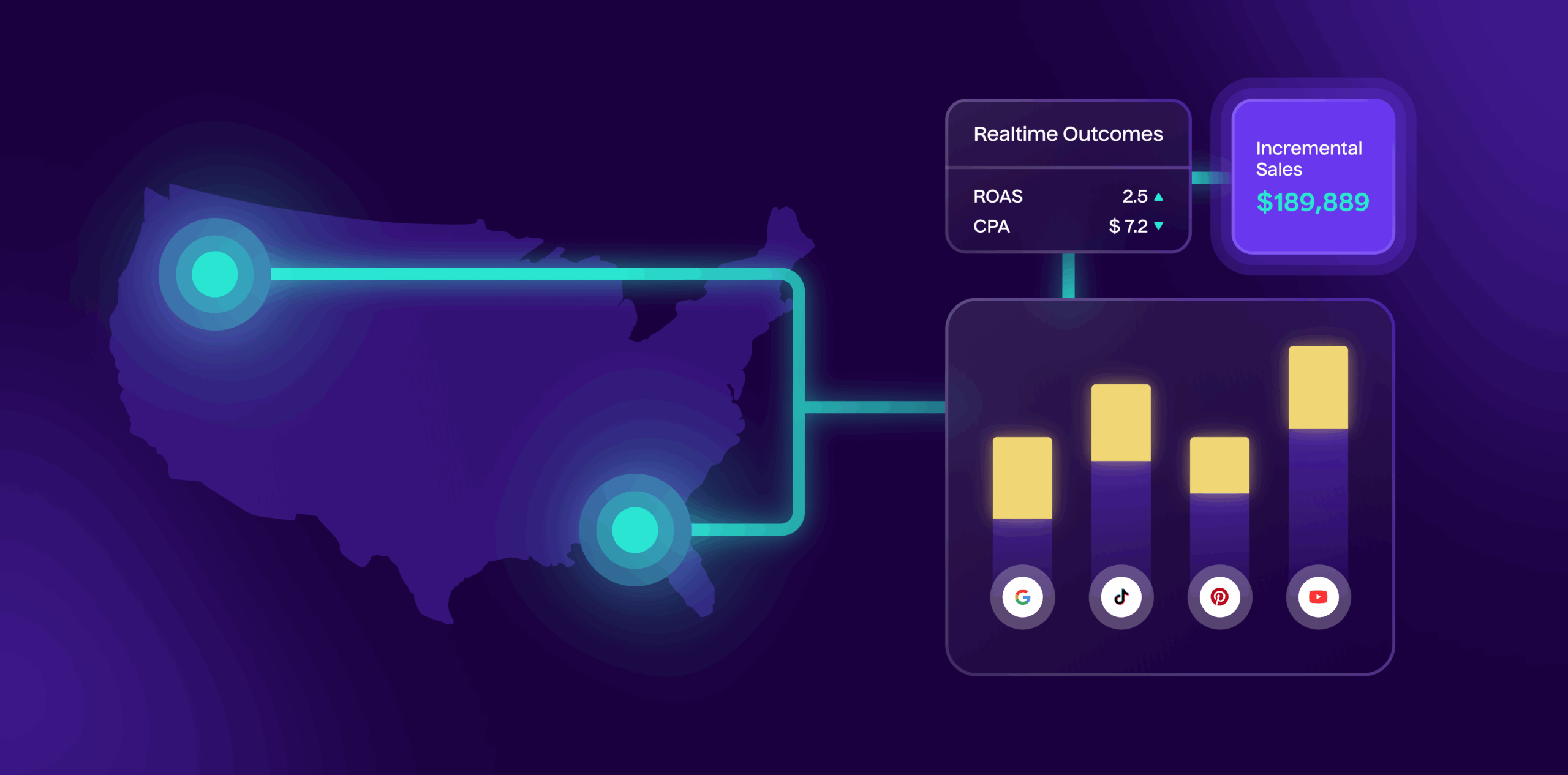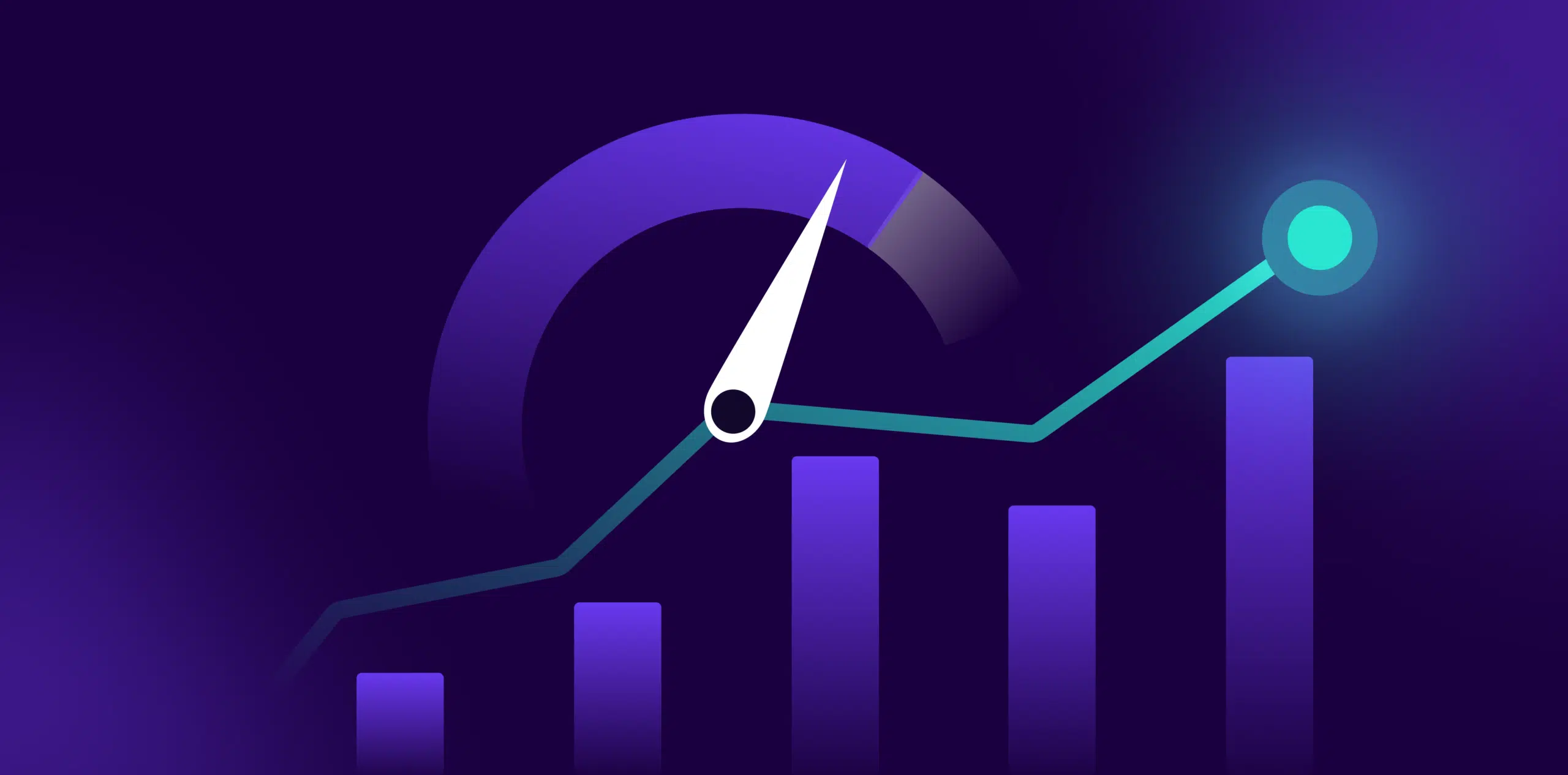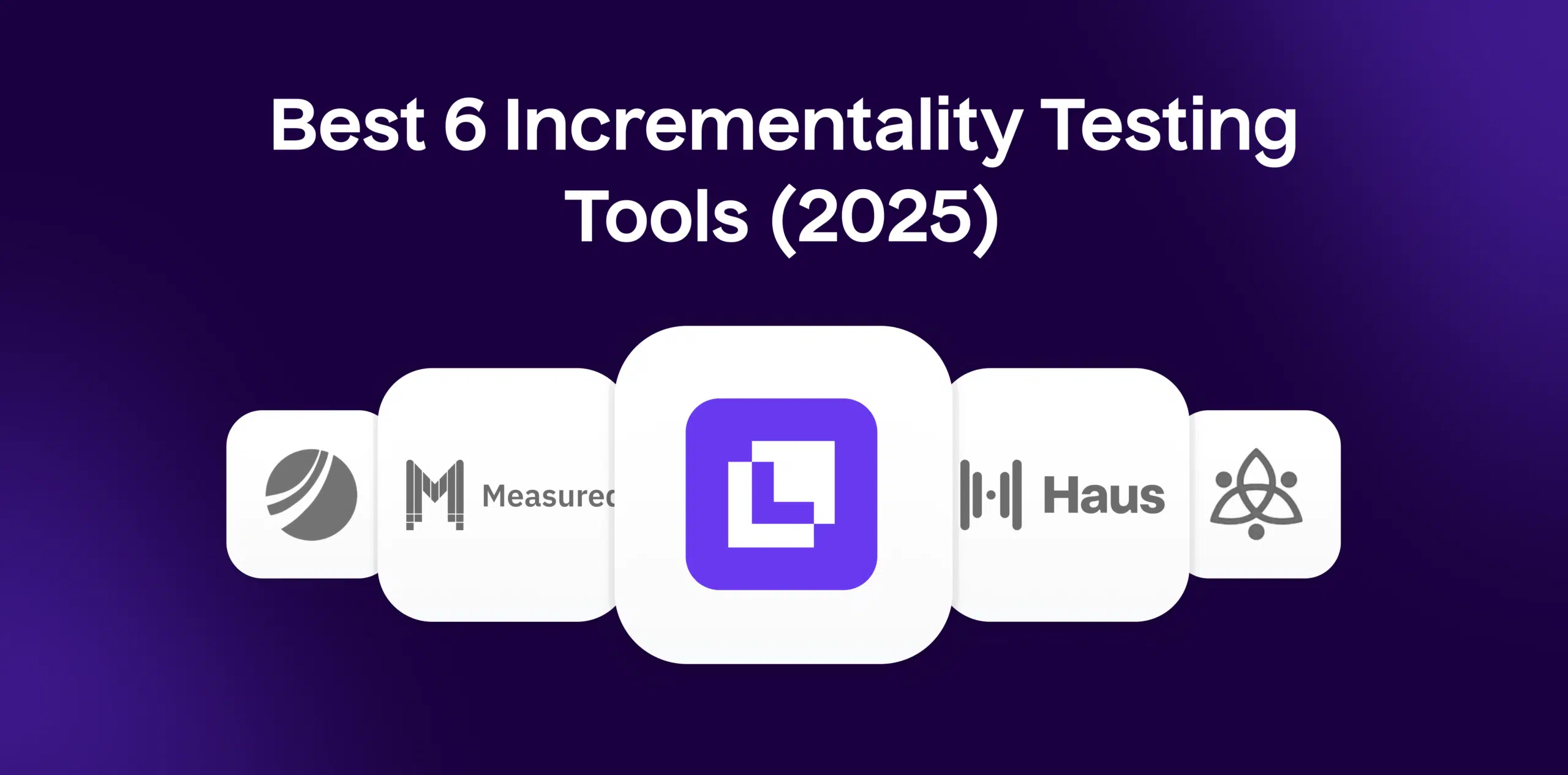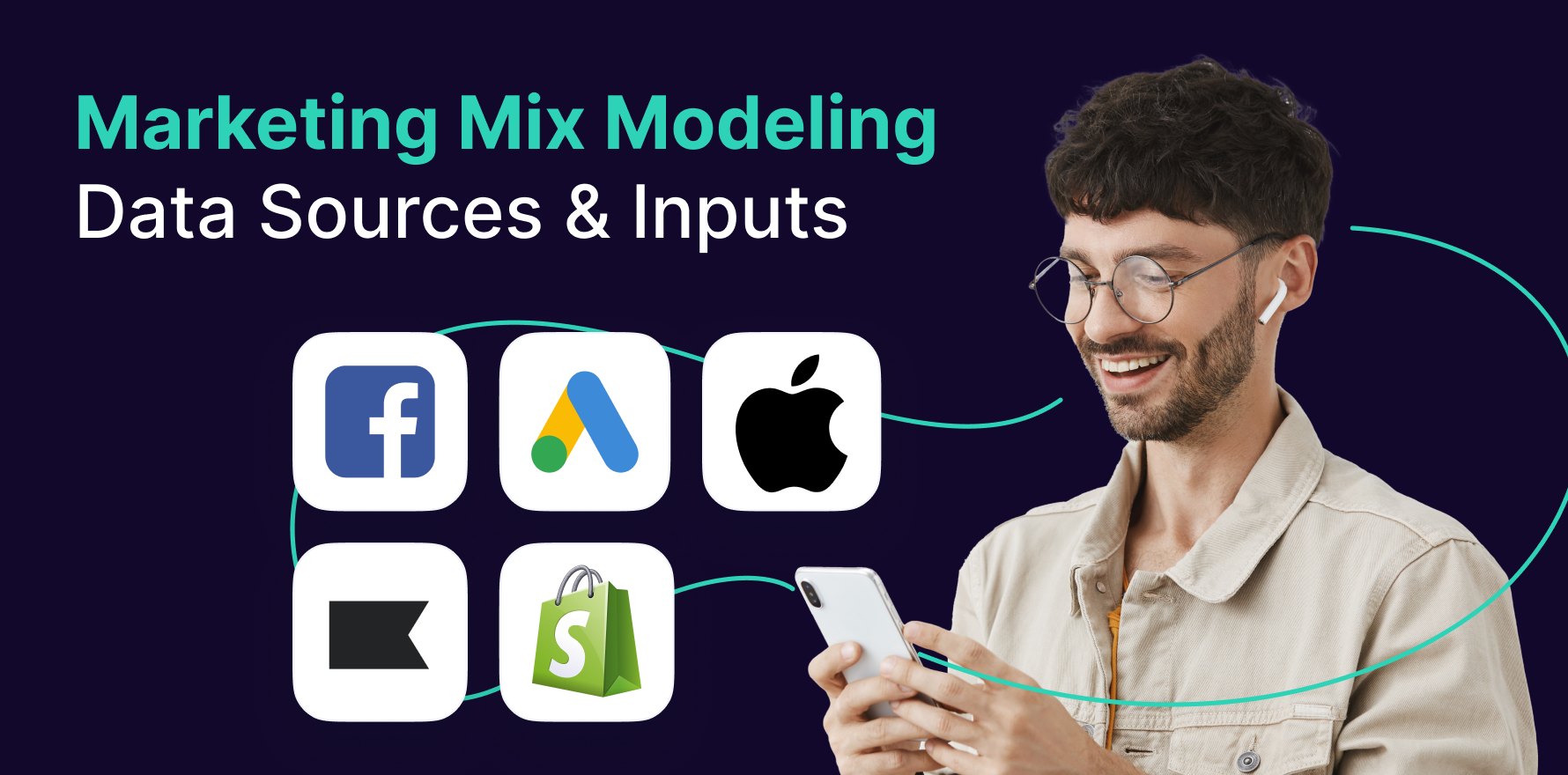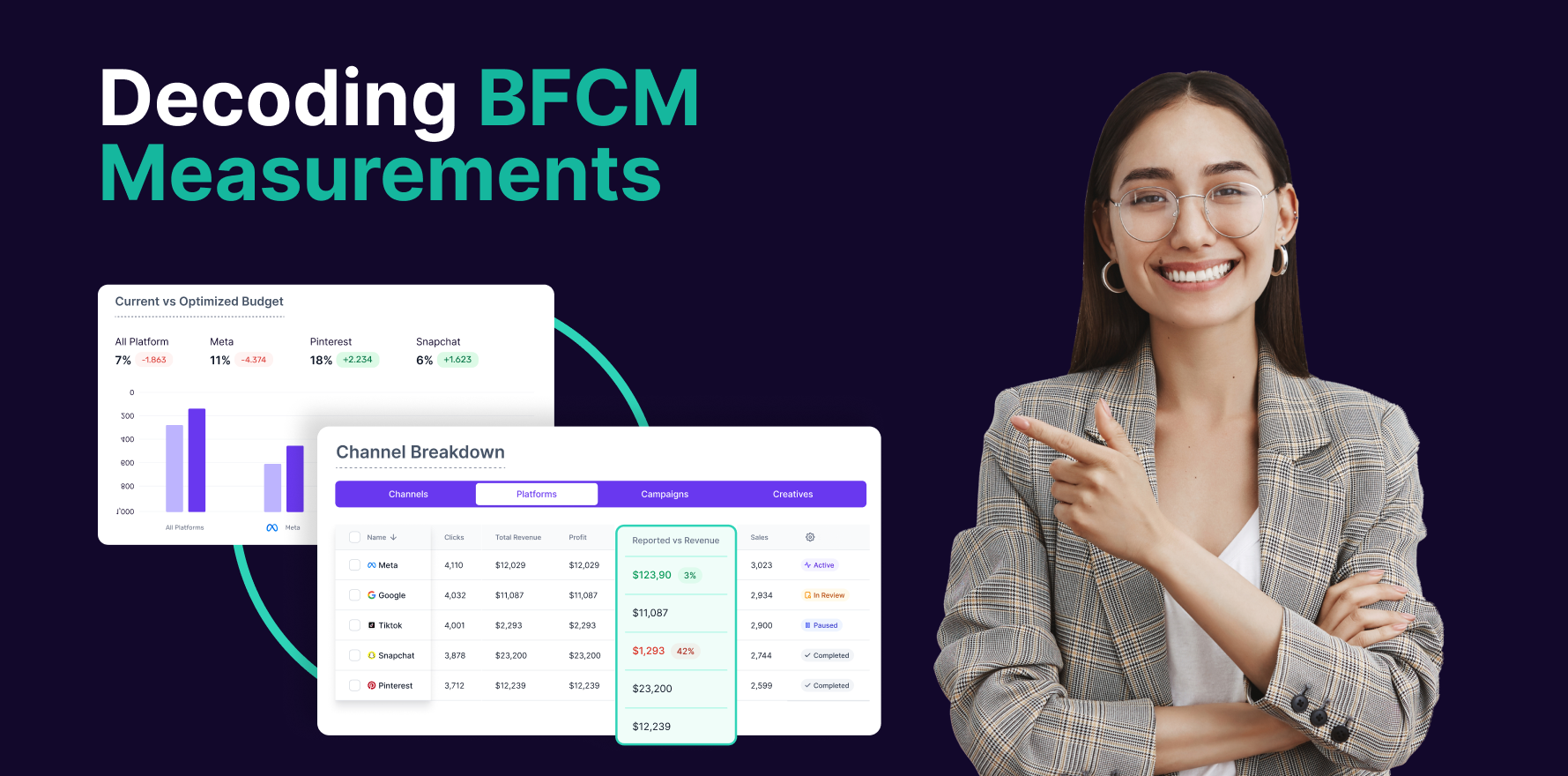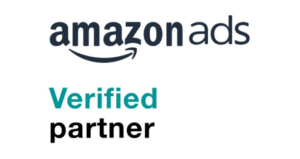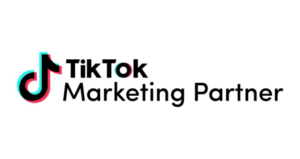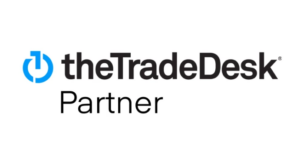Incrementality testing in marketing and advertising is the practice of measuring the true incremental impact of a specific campaign or strategy by isolating its effects through various methodologies, often via geographic, audience splits, or time-series toggles.
This approach helps determine how many conversions, leads, or dollars would not have occurred without a specific marketing activity. By comparing a test group (exposed) against a statistically similar control group (unexposed), marketers can calculate incremental lift, demonstrating true cause and effect rather than relying on correlational attribution.
According to Emarketer and Transunion’s July 2025 data report, over half (52%) of brands and agencies are using incrementality testing to measure and optimize their campaigns
Incrementality Testing Examples
Scenario 1: A D2D Brand – Social Ads Impact
A direct-to-consumer (DTC) beauty brand pauses paid social ads in 20% of its U.S. DMAs (Designated Market Areas) for four weeks, while maintaining normal ad spend in the remaining regions.
1.1 Test Design:
- Test Group: DMAs with no paid social ads (holdout group)
- Control Group: DMAs with ongoing paid social ads (BAU group)
1.2 Results:
Sales in the test DMAs declined by 12% compared to the pre-test baseline, while sales in the control DMAs remained stable, with business as usual (BAU).
→ This indicates a 12% incrementality attributed to paid social advertising.
1.3 Action Taken:
The brand reallocated budget to the creative assets that drove the lift and reduced spend on retargeting tactics that showed no incremental impact.
Scenario 2: B2B SaaS – LinkedIn Ads Impact
A B2B SaaS company pauses LinkedIn ad campaigns in 30% of its key regions for six weeks while continuing to spend in the rest.
2.1 Test Design:
- Test Group: Regions with paused LinkedIn ads.
- Control Group: Regions with active LinkedIn ads.
2.2 Results:
Demo requests in the test regions dropped by 18% compared to baseline, while control regions held steady.
→ An 18% incrementality is attributed to LinkedIn advertising.
2.3 Action Taken:
The company increased investment in high-performing ad formats (video + lead gen forms) and cut back on static ads with low incrementality.
Case Studies & Real‑World Applications of Incrementality Testing
1. Seidensticker achieves 11.5% higher revenue with 11.7% lower ad spend
Seidensticker is a fashion and apparel giant brand with an omnichannel presence, producing millions of garments and operating all over the world. Through Lifesight’s Incrementality testing, Seidensticker has achieved 11.5% higher revenue, 11.7% lower ad spend, along with 19.3% uplift in the incremental ROAS (iROAS).
2. Premier Auto Dealership Chain Increases Incremental Revenue by 65% With Unified Measurement
A leading Canadian automobile dealership changed its marketing strategy to overcome declining visits and revenue but struggled to identify high performing channels for its marketing efforts. Lifesight’s unified marketing measurement helped them increase their revenue by 65% by adopting the recommendations and optimizing their marketing channels.
3. How Lifesight’s iROAS optimization boosted iRevenue by 45% for an omnichannel Retailer
An omnichannel Retailer thought to move beyond ROAS to drive sales and growth profit across in store and online channels. They joined Lifesight to maximize the impact of their advertising through incremental sales. Lifesight helped omnichannel retailer to drive irevenue by 45%
4. Ecommerce Company gained 15% in conversions and a 20% increase in ROI
A well-known ecommerce company has been seeing substantial growth in traffic and an increase in sales, and by doing all marketing efforts in terms of online and offline. They want to know which particular channels and campaigns are helping them to gain success and which campaigns are underperforming. By using the Lifesight Incrementality testing, the brand got to know which campaigns were helping them, and by Lifesight’s recommendations, they gained 15% in conversions and a 20% increase in ROI.
Types of Incrementality Tests
There are three types of incrementality testing
- Geo Experiments
- Audience Segments
- Time-series On/Off Tests
We’ve explained each in detail below.
Method |
How It Works |
Best For |
Watch‑outs |
| Geo Experiments | Use synthetic control methodologies to assign test and control groups. | High‑spend digital (Meta, YouTube, CTV) & offline (OOH, TV) | Needs ≥20 markets, spend balance |
| Audience Segments | Split customer/prospect lists into exposed vs. holdout | Email, loyalty, retargeting | Maintain cohort exclusivity |
| Time-series On/Off Tests | Alternate campaign on vs. off by week/day | Channels lacking geo controls | Sensitive to seasonality, halo effects |
Here’s the detailed overview of the Types of Incrementality Testing
1. Geo Experiments
- Geo experiments work by pairing a group of geographic (test) markets, such as Designated Market Areas (DMAs), with a control group, algorithmically built to precisely mimic the historical performance trends of the test group. A change in marketing is then applied to the test group, and the resulting lift is measured by comparing its performance against the control group.
- This method is especially effective for high-investment channels like Meta, YouTube, connected TV (CTV), out-of-home (OOH), and linear TV.
- It’s best suited for advertisers with at least 20 distinct markets and enough spend to maintain balance across regions. One watch-out is ensuring market comparability and sufficient sample size to detect lift.
2. Audience Segment Testing
- Audience split testing involves dividing a defined customer or prospect list into exposed and holdout groups. One group receives the marketing treatment (e.g., email campaign, loyalty offer, or retargeting ad), while the other does not.
- This method works well for channels where individual-level targeting is possible. To get clean results, it’s crucial to maintain strict cohort exclusivity and ensure there is no cross-contamination between groups.
3. Time-Series On/Off Testing
- This approach toggles campaigns on and off over time, such as alternating ad spend weekly or daily, and analyzes performance changes.
- It’s useful for channels that don’t support geo targeting or audience-level control.
- However, time-series tests are particularly sensitive to external variables like seasonality, competitor activity, and halo effects from other campaigns, which can distort results.
What Are the Benefits of Measuring the Incrementality of Your Marketing Efforts?
1. It helps in Eliminating Waste Spend
Identify non-incremental spend, such as ineffective retargeting or cannibalistic ads, and reallocate budget to what truly drives results.
2. Builds Financial Credibility
Move beyond vanity metrics like platform ROAS by using incrementality to report causally sound metrics like iROAS (incremental return on ad spend).
3. Improves Forecasting of Marketing Campaigns
Calibrate your Marketing Mix Models (MMM) by feeding in incrementality-based lift factors, enabling more accurate long-term budget planning.
4. Future-Proof Measurement
Incrementality testing works by comparing the performance of matched groups (like geographic regions) rather than user-level tracking, making it resilient to IDFA deprecation and cookie loss.
How Incrementality Testing Works? A Technical Step-By-Step Deep Dive
STEP 1: Define Hypothesis & KPI
Start with a clear, testable hypothesis and a measurable KPI.
Example: “TikTok drives new-to-file (NTF) customers at an incremental CAC below $50.”
STEP 2: Design Treatment Type
Once the hypothesis and the KPI is established, the next step is to apply a treatment to the test group. This could either be a scale-up test to measure the ROI of additional investment or a holdout test to quantify the value of your existing activity.
STEP 3: Choose markets and Conduct Power Analysis
Choose the test and control groups and then calculate the required sample size to detect a meaningful effect with ≥80% statistical power.
You’ll need estimates for:
- Expected lift (effect size)
- Variance in outcomes
- Desired confidence level (typically 90–95%)
STEP 4: Execute the Test
Implement your test with discipline:
- Apply spend guardrails to prevent overspend or underspend
- Monitor pre-test trends to validate group similarity (look for R² ≥ 0.9 between test and control)
STEP 5: Calculate Lift
After the test:
- Compare post-test means between treatment and control groups
- Compute statistical significance using a p-value or Bayesian posterior probability to estimate true lift
STEP 6: Make Decisions
Based on the results:
- Reallocate budget to high-performing channels or tactics
- Feed lift values back into Marketing Mix Models (MMM)
- Schedule follow-up tests to refine strategy or explore other variables
How to Implement Incrementality Testing in Your Marketing Campaigns? A Step-by-Step Workflow
There are five phases to implementing incrementality testing in your marketing campaigns: the scoping phase, design and setup phase, execution phase, analysis and read-out phase, and finally, the iteration phase.
Phases |
Owner |
Actions |
Tooling |
| Scoping | Growth Lead | Define hypothesis, KPI, duration | Experiment brief template |
| Design & Setup | Marketing Ops | Tag markets/audiences, configure holdouts, QA pixels | Lifesight GeoLift, platform APIs |
| Execution | Marketing Science | Monitor spend, pre‑trend diagnostics, power meter | Live Lift Dashboard |
| Analysis & Read‑out | Analytics + Finance | Calculate lift, iROAS, payback; publish deck | Incrementality Read‑out Template |
| Iterate | Channel Owners | Reallocate budget, feed lift into MMM | Scenario Planner |
Here’s the detailed step-by-step explanation about the incrementality testing implementation workflow
STEP 1: Scoping the Experiment
The process begins by clearly defining the hypothesis, primary KPI, and test duration. This foundational step ensures alignment across teams and clarifies what success looks like.
- Action: Draft an experiment brief outlining the business question, desired outcomes, and thresholds for success.
- Tooling: Experiment Brief Template
- Owner: Growth Lead
STEP 2: Design & Setup
With the scope defined, the next phase focuses on designing the experiment structure. This includes tagging audiences or markets, configuring holdouts, and ensuring all tracking mechanisms are in place and functioning properly.
- Action: Finalize audience splits, targeting rules, and channel-level configurations.
- Tooling: Lifesight GeoLift Tool, Platform APIs (Meta, Google, TikTok, etc.)
- Owner: Marketing Ops
STEP 3: Execute the Test
Once setup is complete, the experiment is launched. During this phase, it’s crucial to monitor the test in real time to maintain integrity and ensure it stays within statistical and budgetary parameters.
- Action: Track campaign spend, validate pre-test trend similarity (e.g., R² ≥ 0.9), and flag anomalies early.
- Tooling: Live Lift Dashboard, Power Meter Diagnostics
- Owner: Marketing Science
STEP 4: Analyze Results & Share Read-Out
After the test period ends, the focus shifts to analyzing outcomes. This includes calculating incremental lift, iROAS, and payback, then synthesizing findings into a clear and actionable read-out.
- Action: Quantify the impact, visualize the data, and align with cross-functional teams on business implications.
- Tooling: Incrementality Read-Out Template
- Owner: Analytics + Finance
STEP 5: Iterate & Optimize
With insights in hand, the final step is to operationalize learnings. This means reallocating budget to incremental drivers, feeding lift values into models like MMM, and planning follow-up tests to deepen understanding.
- Action: Prioritize channels and creatives that show causal impact; schedule the next round of experimentation.
- Tooling: Scenario Planner
- Owner: Channel Owners
What Does Incrementality Testing Measure?
- Incremental Conversions / Revenue (Δ)
- Incremental Lift %
- Incremental Return on Ad Spend (iROAS)
- Incremental CAC / CPA
- Payback Period
- Confidence Intervals & p‑values
Formulas to Calculate Incrementality
1. Incremental Lift %
Lift % = (Treatment – Control) / Control
2. Incremental Revenue
Δ Revenue = Lift % × Control Revenue
3. iROAS
iROAS = Incremental Revenue / Spend
4. Sample Size (simplified)
n ≈ 16 × σ² / δ² (95% confidence; where δ = expected lift, σ = KPI standard deviation)
How to Calculate Incrementality of Your Marketing Efforts? A Step-By-Step Guide
Once your incrementality test is complete, the next critical step is to analyze the results to determine whether your marketing activity truly drove incremental outcomes.
By following these steps, you can confidently measure the true incremental impact of your marketing campaigns, enabling smarter budget decisions, better forecasting, and stronger attribution models.
STEP 1. Collect Post-Period KPI Data
Begin by gathering the key performance indicators (KPIs) from both the test group (exposed to the marketing activity) and the control group (unexposed). Common KPIs include sales revenue, new customer acquisition, leads, or conversions.
Make sure the data spans the full duration of the test and matches the defined success metric from your hypothesis.
STEP 2. Normalize for Population Size (if using Geo-Based Tests)
If your experiment used geographic holdouts (e.g., DMAs), normalize the KPI data to account for population differences across regions. A common approach is to use sales per capita or conversions per 1,000 people.
This ensures that large population differences don’t skew your lift calculation.
STEP 3. Calculate Incremental Lift and iROAS
Use the following formulas to compute impact:
- Incremental Lift = (Test Group KPI – Control Group KPI) ÷ Control Group KPI
- Incremental ROAS (iROAS) = (Incremental Revenue ÷ Incremental Spend)
This gives you both the percentage impact of the marketing activity and a causal return on ad spend, which is more meaningful than platform-reported ROAS.
STEP 4. Run a Significance Test
To determine whether the observed lift is statistically meaningful, conduct a significance test:
- Use a t-test if you’re comparing group means with normal distribution and sufficient sample size.
- Use Bayesian analysis to estimate the posterior probability of a true lift, especially when working with small samples or uncertainty.
Statistical confidence (e.g., p < 0.05) ensures that your result isn’t due to chance.
STEP 5. Perform Sanity Checks
Before making decisions based on the results, validate the experiment’s integrity:
- Pre-trend analysis: Ensure that the control and test groups were behaving similarly before the test began (e.g., R² ≥ 0.9).
- Media leakage check: Confirm that the control group wasn’t accidentally exposed to the campaign.
- Spend consistency: Verify that the test ran with planned spend guardrails and no mid-test changes.
These sanity checks help ensure the observed lift is due to your marketing activity not noise, bias, or setup flaws.
How to Measure the Impact of Incrementality Testing
- Primary Metrics: Incremental sales, iROAS, CAC, conversion‑rate lift.
- Secondary Metrics: Average order value, lifetime value projections, marginal ROI.
- Visualization: Waterfall chart showing total sales → non‑incremental → incremental.
Include KPI tiles on dashboards so execs can grasp impact at a glance.
Automate Incrementality Testing
Modern platforms like Lifesight’s Incrementality Testing Tool can automate:
- Geo market matching & randomization
- Real‑time lift estimations with Bayesian models
- Guardrails for spend leakage and pre‑trend divergence
- One‑click read‑out decks with CFO‑ready iROAS and confidence intervals
Automation trims manual effort by ~60% and always allows‑on test‑and‑learn cadences.
Best Incrementality Testing Tools
| Category | Tools | Strengths |
| Unified Marketing Measurement Platforms | Lifesight, Measured, Rockerbox | Full MMM + test orchestration |
| Native Platform Solutions | Meta Conversion Lift, Google Geo Experiments | Fast intra‑platform validation |
| Open‑Source | Meta GeoLift (R), CausalImpact, Synthetic Control | Data‑science flexibility |
Read More: Best Incrementality Testing Tools
Why Lifesight for Incrementality Testing?
- Plug‑and‑Play GeoLift: No‑code market matching and randomization.
- Causal Dashboards: Executive views of incremental revenue, iROAS, marginal ROI.
- Triangulated Insight: Unified MMM + attribution + experiments = single source of truth for finance & marketing.
- Proven Impact: Clients have reallocated >25% of spend from low‑lift retargeting to high‑lift prospecting and achieved double‑digit revenue growth.
- Privacy Safe: Experiments run without cookies or device IDs, future‑proofing measurement.
Ready to prove your next marketing dollar? Explore Lifesight’s GeoLift sandbox and launch your first incrementality test today.
Conclusion
Incrementality testing is the gold standard for proving marketing effectiveness in a privacy-first world. By running statistically robust experiments and automating them with platforms like Lifesight, brands can continuously channel spend toward tactics that truly drive incremental growth and profit.
FAQs
1. Why is Incrementality Testing important for marketing campaigns?
It isolates causal lift, eliminating wasted spend and boosting ROI.
2. How do I set up Incrementality Testing?
Define hypothesis → randomize test/control → run ≥4 weeks → calculate lift.
3. What does Incrementality Testing measure?
Incremental conversions, revenue, iROAS, CAC, payback period.
4. How can Incrementality Testing improve ROI?
By reallocating budget from non‑incremental to high‑lift tactics.
5. What are the challenges in Measuring the Effect of Incrementality Testing?
Sample‑size, clean randomization, external factors like seasonality.
6. Can it be automated?
Yes, tools like Lifesight automate design, execution, and analysis.
7. How accurate is it?
With ≥80% power and proper controls, lift estimates are statistically robust.
8. What campaign types benefit most?
High‑spend channels (paid social, CTV) and emerging platforms with uncertain value.
9. How long will it take to see results?
Typically 4–8 weeks, depending on the sales cycle.
10. What statistical methods are used?
Difference‑in‑means, Synthetic Control, Bayesian hierarchical models.
11. Can it be used for offline channels?
Yes, geo holdouts work for TV, radio, print.
12. Incrementality vs. MMM?
Incrementality experiments provide short-term causal proof, whereas MMM (Marketing Mix Modeling) informs long-term allocation, and both should be used together.
13. How do I calculate lift?
To calculate incremental lift: (Test − Control) / Control ×100.
14. What is the Role of Control Groups?
They represent the counterfactual of what would have happened without the campaign.
You may also like
Essential resources for your success
